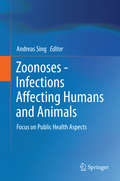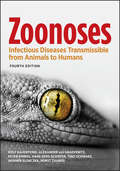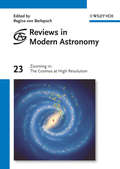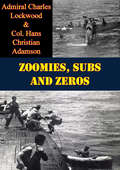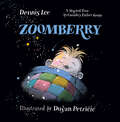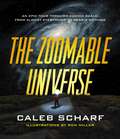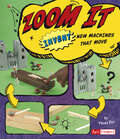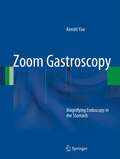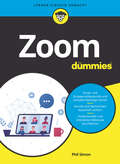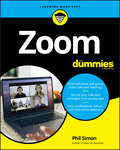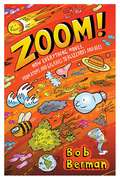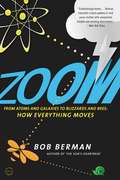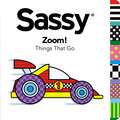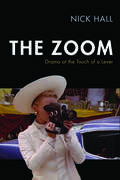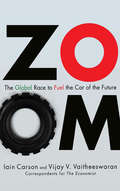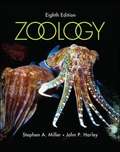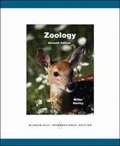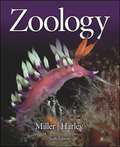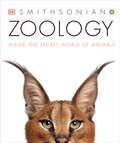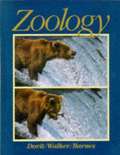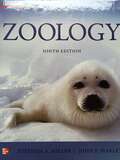- Table View
- List View
Zoonoses - Infections Affecting Humans and Animals
by Andreas SingThe book will cover the most important zoonoses with a public health impact and debate actual developments in this field from a One Health perspective. The outline of the book follows a "setting" approach, i. e. special settings of zoonoses with a public health aspect, rather than presenting a simple textbook of an encyclopedic character. Main chapters will deal with zoonoses in the food chain including a special focus on the emerging issue of antibiotic resistance, with zoonoses in domestic and pet animals, in wildlife animal species (including bats as an important infectious agent multiplier), influenza and tuberculosis as most prominent zoonoses, and zoonotic pathogens as bioterroristic agents. Special interest chapters debate non-resolved and currently hotly debated zoonoses (e. g. M. Crohn/paratuberculosis, chronic botulism) as well as the economic and ecological aspects of zoonoses.
Zoonoses: Infections Affecting Humans and Animals
by Andreas SingThis second fully revised and extended edition of “Zoonoses - Infections Affecting Humans and Animals” covers the most important pathogens impacting both human and animal public health and debates current developments in this interdisciplinary field from a One Health perspective. Following a "setting" approach, the individual chapters each review zoonoses occurring in a specific group of animals, such as production animals, pets or wildlife, or in a defined ecosystem. A focus is put on zoonoses emerging along the food chain and on antibiotic resistance as an increasing challenge in infectious disease management. Special interest chapters debate non-resolved and currently hotly debated zoonoses, foremost COVID-19, influenza, Crohn/paratuberculosis and chronic botulism, also taking into account the economic and ecological aspects of zoonotic disease outbreaks. This second edition includes brand-new chapters on emerging pathogens such as SARS-CoV-2, chlamydia and helminths, it reviews historic zoonoses, provides additional insights into pathogens of reptiles and highlights significant neglected tropical diseases. This reference work is a must-read for researchers, health professionals and students in Microbiology and Veterinary Medicine. The book’s ambition to spread knowledge on zoonoses and on strategies on how to tackle them complies with the United Nations Sustainable Goals, in particular Goal 3 – Good Health and Well-Being.
Zoonoses: Infectious Diseases Transmissible from Animals to Humans (ASM Books #39)
by Et Al. Rolf Bauerfeind Alexander Von Graevenitz Peter KimmigZoonoses are a persistent threat to the global human health Today, more than 200 diseases occurring in humans and animals are known to be mutually transmitted. Classical infectious diseases, such as rabies, plague, and yellow fever, have not been eradicated despite major efforts. New zoonotic diseases are on the increase due global conditions such as overpopulation, wars, and food scarcity, which facilitate human contact with rodents, stray animals, and their parasites. In addition, humans are unwittingly becoming accidental hosts and new links in an infectious chain by engaging in activities such as survival training, which involves camping in open areas and consumption of raw or insufficiently cooked food. Zoonotic infections cause a variety of symptoms that often do not provide clear evidence of a known disease. Zoonoses, Fourth Edition, describes most occurring worldwide zoonosis and facilitates the identification, diagnosis and treatment of zoonotic infections. Written by a team of doctors, medical microbiologists and veterinarians, this completely, revised edition covers all aspects of the epidemiology and prevention of zoonotic diseases through clear descriptions of various illnesses. Specifically, this fourth edition covers zoonosis caused by viruses, bacteria, fungi and parasites infections caused by animal bites infections and intoxications by animal foods Iatrogenic transmission of zoonotic pathogens Zoonoses is an indispensable reference for clinicians and laboratorians.
Zooming in: The Cosmos at High Resolution (Reviews in Modern Astronomy #23)
by Regina Von BerlepschHigh resolution is a key element in research in astronomy and cosmology. Advances in instrumentation and new methods are enabling us to constantly make new exciting discoveries, and progress in theoretical modelling allows us to gain a deeper understanding of cosmic physics. One example of this progress in instrumentation and observing strategy have made possible the discovery of a rich population of low-mass planets orbiting solar-type stars (Michel Mayor et al., Karl Schwarzschild Lecture 2010). This 23rd volume in the series Reviews of Modern Astronomy contains 14 invited reviews and highlight contributions presented during the 2010 annual meeting of the Astronomical Society on the topic "Zooming in: The cosmos at high resolution", held in Bonn, Germany, in September 2010.
Zoomies, Subs And Zeros
by Admiral Charles Lockwood Col. Hans Christian AdamsonThe exploits of the Submarine Rescue League, which had the job of picking up American flyers shot down while attacking objectives in the Pacific.'In writing this book, the authors had a triple purpose.First, to write the superbly human history of the Submarine Lifeguard League while those who participated in its creation and in its splendid work are still among us to tell that story. It is a chapter of Naval and Air Force operations in the Pacific that richly deserves preservation.Second, to convey to submariners whose vessels took part in the saving of the lives of hundreds of Air Force, Navy, and Marine Corps men an essential picture of the overall scope of their activities; as well as to give aviators whose lives were saved by submarines--and their families--a view of the far-flung operations established for snatching airmen from Japs as well as from death at sea.There remains one more reason for the writing of this book and, perhaps, it is, after all, the most important: namely, to impress upon those who have a voice in such matters at defense and Congressional levels that with new long-range planes and nuclear powered submarines, the lifesaving know-how acquired by submarine and air commanders through bitter and time-consuming experiences should be preserved for future generations of submariners and airmen.'-Author's Preface.
Zoomberry: Fixed Format Layout
by Dennis LeeZoomberry, zoomberry, zoomberry pie:Zoomberry, zoomberry, now I can fly.Who hasn’t dreamed of flying? In this enchanting bedtime poem by Canada’s Father Goose, a crotchety wizard shares his secret spell for taking flight. Based on Dennis Lee's “The Wizard,” from his acclaimed collection Melvis and Elvis, and gorgeously illustrated by award-winning illustrator Dusan Petricic, Zoomberry is a magical adventure for the very young that will send readers soaring through nighttime skies."
The Zoomable Universe: An Epic Tour Through Cosmic Scale, from Almost Everything to Nearly Nothing
by Ron Miller Caleb ScharfAn epic, full-color visual journey through all scales of the universeIn The Zoomable Universe, the award-winning astrobiologist Caleb Scharf and the acclaimed artist Ron Miller take us on an epic tour through all known scales of reality, from the largest possible magnitude to the smallest. Drawing on cutting-edge science, they begin at the limits of the observable universe, a scale spanning 10^27 meters—about 93 billion light-years. And they end in the subatomic realm, at 10^-35 meters, where the fabric of space-time itself confounds all known rules of physics. In between are galaxies, stars and planets, oceans and continents, plants and animals, microorganisms, atoms, and much, much more. Stops along the way—all enlivened by Scharf’s sparkling prose and his original insights into the nature of our universe—include the brilliant core of the Milky Way, the surface of a rogue planet, the back of an elephant, and a sea of jostling quarks.The Zoomable Universe is packed with more than 100 original illustrations and infographics that will captivate readers of every age. It is a whimsical celebration of discovery, a testament to our astounding ability to see beyond our own vantage point and chart a course from the farthest reaches of the cosmos to its subatomic depths—in short, a must-have for the shelves of all explorers.
Zoom It: Invent New Machines That Move (Invent It Ser.)
by Tammy EnzDo you have a need for speed? Does power make your heart pound? In Zoom It, you’ll invent a gas powered boat, a catapult, an electric car, and many other amazing moving contraptions. When it comes to inventing, your imagination has no limits!
Zoom Gastroscopy
by Kenshi YaoSince magnifying endoscopy of the stomach, or zoom gastroscopy, was first performed at the beginning of the 21st century , there have been numerous findings in the field worldwide. The author of this volume has developed a standardized magnifying endoscopy technique that enables endoscopists to constantly visualize the microanatomy (subepithelial capillaries and the epithelial structure) within the stomach. With this technology, it has become easy to obtain magnified endoscopic findings. Techniques differ, however, depending upon the endoscopist. Endoscopists around the world do not have a standardized magnifying endoscopy technique, which is mandatory for the scientific analysis of their findings. In addition, there is no logical explanation for how and which microanatomies are visualized by magnifying endoscopy with narrow-band imaging in the glandular epithelium of the stomach. This inconsistency results in considerable confusion among researchers and clinicians and a lack of terminology for the purposes of analysis. As magnifying endoscopy with narrow-band imaging (NBI) becomes more popular throughout the world, there is increased demand for a specialized reference book focused on this subject. The aims of the present volume, Zoom Gastroscopy: Magnifying Endoscopy in the Stomach, are manifold: (1) to illustrate the standard magnifying endoscopic technique that can visualize subepithelial mucosal microvessels as small as capillaries, the smallest unit of blood vessels in the human body, (2) to explain the optical phenomena and principles for NBI and its application to magnifying endoscopy, (3) to clarify which microanatomies are visualized by magnifying endoscopy with NBI and how this is achieved, and (4) to present a diagnostic system so called "VS classification system" for early gastric neoplasias. With a single author, the book consistently uses uniform anatomical terms to describe endoscopic findings, providing an essential reference for endoscopists in the world.
Zoom für Dummies (Für Dummies)
by Phil SimonSie wollen oder müssen Zoom zur Kommunikation nutzen? Egal ob privat oder geschäftlich, es gibt viele Funktionen, Einstellungen und Tipps, die Ihnen das Leben leichter machen. Phil Simon erklärt Ihnen in diesem Buch alles, was Sie über Chat, Videokonferenzen und das Einbinden von Apps wissen müssen. Egal ob das Erstellen von Einladungen, das Aufzeichnen von Konferenzen oder die Nutzung von Zoom Phones, alles wird ausführlich und leicht verständlich anhand von Screenshots erklärt. So nutzen Sie Zoom entspannt und effizient.
Zoom For Dummies
by Phil SimonUnlock the full potential of Zoom with this straightforward resource Zoom For Dummies shows readers how to stay connected to their friends, family, colleagues, and peers with this explosively popular communication platform. Written by business professional Phil Simon, Zoom For Dummies allows you to take full advantage of Zoom’s multi-faceted feature set, including: The "Meetings" feature Webinar capabilities Instant messaging functionality Zoom’s “Channel” features Zoom For Dummies goes beyond video conferencing and unlocks the full power of this service. You’ll be able to connect with people around the globe, record and replay video, share your screen with others, and use Zoom on your desktop, laptop, tablet, and mobile device. The book shows you how to follow best practices when it comes to Zoom’s enhanced security features, as well as how to keep Zoom up to date. Written in the friendly style the For Dummies series is famous for, Zoom For Dummies is perfect for anyone who uses Zoom for school, work, business, or personal reasons.
Zoom: How Everything Moves, from Atoms and Galaxies to Blizzards and Bees
by Bob BermanThis brilliantly inventive fantasy epic by the award-winning author of Watership Down immerses the reader in a medieval world complete with created languages, detailed maps and elaborate traditions and rituals. Centring on the long-awaited reincarnation of a giant bear among the half-barbaric Orelgan people, Shardik's appearance sets off a violent chain of events as faith in his divinity sweeps the land. Closest to the bear is the hunter Kelderek, a naturally pious, ignorant, well-meaning man who becomes - in his dedication to Shardik - a prophet, victorious soldier, corrupt priest-king and ruler of an empire.A gripping tale of war, adventure, morality and slavery, horror and romance, Shardik is a remarkable exploration of mankind's universal desire for divine incarnation, and the corrosive influence of power. Recently ranked in the top 100 bestsellers over the past 40 years by the Sunday times, Shardik is a book for our age.
Zoom: How Everything Moves
by Bob BermanFrom the speed of light to moving mountains--and everything in between--ZOOM explores how the universe and its objects move.If you sit as still as you can in a quiet room, you might be able to convince yourself that nothing is moving. But air currents are still wafting around you. Blood rushes through your veins. The atoms in your chair jiggle furiously. In fact, the planet you are sitting on is whizzing through space thirty-five times faster than the speed of sound.Natural motion dominates our lives and the intricate mechanics of the world around us. In ZOOM, Bob Berman explores how motion shapes every aspect of the universe, literally from the ground up. With an entertaining style and a gift for distilling the wondrous, Berman spans astronomy, geology, biology, meteorology, and the history of science, uncovering how clouds stay aloft, how the Earth's rotation curves a home run's flight, and why a mosquito's familiar whine resembles a telephone's dial tone.For readers who love to get smarter without realizing it, ZOOM bursts with science writing at its best.
Zoom!: Things That Go (Sassy)
by Grosset & DunlapMom, dad, and baby will love our line of books from Sassy, the award-winning and innovative toy company. This book teaches babies all about things that go zoom! Cars, trucks, boats, and airplanes are just some of the vehicles babies will learn about in this book.
The Zoom: Drama at the Touch of a Lever (Techniques of the Moving Image)
by Nick HallFrom the queasy zooms in Alfred Hitchcock’s Vertigo to the avant-garde mystery of Michael Snow’s Wavelength, from the excitement of televised baseball to the drama of the political convention, the zoom shot is instantly recognizable and highly controversial. In The Zoom, Nick Hall traces the century-spanning history of the zoom lens in American film and television. From late 1920s silent features to the psychedelic experiments of the 1960s and beyond, the book describes how inventors battled to provide film and television studios with practical zoom lenses, and how cinematographers clashed over the right ways to use the new zooms. Hall demonstrates how the zoom brought life and energy to cinema decades before the zoom boom of the 1970s and reveals how the zoom continues to play a vital and often overlooked role in the production of contemporary film and television.
Zoom: The Global Race to Fuel the Car of the Future
by Vijay V. Vaitheeswaran Iain Carson"Zoom goes zero to sixty in nothing flat. It's an exciting ride into the future of the world's favorite physical object, the automobile." -Gregg Easterbrook, author of THE PROGRESS PARADOX "Zoom offers a new way to think about cars and energy that's key to understanding the forces shaping business today. It's smart, well-informed and insightful--exactly what one would expect from two of The Economist's best journalists." -Chris Anderson, author of THE LONG TAIL "Zoom puts oil in its sights and squeezes off one telling round after another. Car lovers will see a sunny future with other fuels; OPEC a steadily darkening twilight." -R. James Woolsey, VP, Booz Allen Hamilton; former Director of Central Intelligence "An incisive analysis of the end of the petroleum age, including all its repercussions and opportunities." -Vinod Khosla, Khosla Ventures "Oil is the problem. Cars are the solution." Those two simple sentences by the authors of Zoom define the scope of their illuminating and important book, an examination of a transformation in business and culture that is occurring before our eyes. We are living in the midst of a Great Awakening. People are seeking environmentally-sound alternatives to gas guzzlers. Detroit's reign is over. Oil companies, despite their billion-dollar profits, could be on the brink of extinction if they don't adapt. And citizens, all too aware that these industries have lobbied politicians into gridlock over energy policy, are mobilizing to support leaders who advocate new policies. In Zoom, Iain Carson and Vijay V. Vaitheeswaran, award-winning correspondents for The Economist, show why and how geopolitical and economic forces are compelling the linked industries of oil and autos to change as never before. Drawing on years of industry research-including dozens of interviews with motor and energy executives, top policymakers, and latter-day Fords and Edisons-Carson and Vaitheeswaran explain: -How Toyota became the world's largest automaker through innovation and superior performance. -Why American politicians have, for decades failed to address our energy issues and global warming-and how grassroots movements, along with individual entrepreneurs, innovators, and outsiders, are making real reform possible. -How these Green revolutionaries are creating new products powered by hydrogen, electricity, bio-fuels, and digital technology. As political leaders debate our energy, environmental and economic future, Zoom offers a lucid and visionary portrait of what that future could be. Anyone planning to vote will find compelling truth in its assertions and conclusions.
Zoology for Kids: Understanding and Working with Animals, with 21 Activities
by Bethanie Hestermann Josh Hestermann The Kratt BrothersAn interactive introduction to working with animals Zoology for Kids invites the next generation of zoologists to discover the animal kingdom through clear, entertaining information and anecdotes, lush color photos, hands-on activities, and peer-reviewed research. Young minds are introduced to zoology as a science by discussing animals' forms, functions, and behaviors as well as the history behind zoos and aquariums. Related activities include baking edible animal cells, playing a dolphin-echolocation game, and practicing designing an exhibit. Young readers can peek into the world of zookeepers and aquarists, veterinarians, wildlife researchers, and conservationists as they "train" their friends, mold a tiger's jawbone, and perform field research in their own backyard. This engaging resource provides readers with new knowledge, a healthy respect for the animal kingdom, and the idea that they can pursue animal-related careers and make a difference to preserve and protect the natural world.
Zoology (Eighth Edition)
by Stephen A. Miller Harley John P. HarleyThe 8th edition of Zoology continues to offer students an introductory general zoology text that is manageable in size and adaptable to a variety of course formats. It is a principles-oriented text written for the non-majors or the combined course, presented at the freshman and sophomore level. Zoology is organized into three parts. Part One covers the common life processes, including cell and tissue structure and function, the genetic basis of evolution, and the evolutionary and ecological principles that unify all life. Part Two is the survey of protists and animals, emphasizing evolutionary and ecological relationships, aspects of animal organization that unite major animal phyla, and animal adaptations. Part Three covers animal form and function using a comparative approach. This approach includes descriptions and full-color artwork that depict evolutionary changes in the structure and function of selected organ systems.
Zoology 7th Edition
by Stephen A. Miller John P. HarleyThis is a principles-oriented introductory zoology text for non-majors or combined majors/non-majors (freshman-sophomore level). The emphasis is on basic concepts at the most accessible level for students with no science background.
Zoology (6th Edition)
by Stephen A. Miller John P. HarleyThe textbook is organized into three parts. Part One covers the common life processes, including cell and tissue structure and function, the genetic basis of evolution, and the evolutionary and ecological principles that unify all life. Part Two is the survey of protists and animals, emphasizing evolutionary and ecological relationships, aspects of animal organization that unite major animal phyla, and animal adaptations. Part Three covers animal form and function using a comparative approach.
Zoology (3rd Ed.)
by Stephen A. Miller John P. HarleyThe new 7th edition of "Zoology" continues to offer students an introductory general zoology text that is manageable in size and adaptable to a variety of course formats. It is a principles-oriented text written for the non-majors or the combined course, presented at the freshman and sophomore level. "Zoology" is organized into three parts. Part One covers the common life processes, including cell and tissue structure and function, the genetic basis of evolution, and the evolutionary and ecological principles that unify all life. Part Two is the survey of protists and animals, emphasizing evolutionary and ecological relationships, aspects of animal organization that unite major animal phyla, and animal adaptations. Part Three covers animal form and function using a comparative approach. This approach includes descriptions and full-color artwork that depict evolutionary changes in the structure and function of selected organ systems.
Zoology: Inside the Secret World of Animals (DK Secret World Encyclopedias)
by DKSee the animal kingdom in all its glory, from jellyfish to polar bears, with up-close details of their unique features from head to toe. Filled with magnificent photographs that were specially commissioned for this book and cannot be seen anywhere else. Written in association with the Smithsonian Institution.This visual reference book starts with the question "what is an animal?" and takes you through the animal kingdom - mammals, reptiles, birds, and sea creatures. It uses a unique head-to-toe approach that showcases in spectacular detail special features like the flight feathers of a parrot, the antenna of a moth, or the tentacles of coral.This visual encyclopedia is filled with clear and fascinating information on everything about the social lives of animals. Read exciting stories like how animals communicate, defend their territories, and attract mates.Learn how evolution has helped wildlife to adapt to their unique environments, whether it's the ability to live in difficult habitats, adjust to specific diets, or how they work physically.Humans have drawn and painted animals for thousands of years. Zoology has included some of these, like early rock art that depicts our awe of the animal kingdom or natural history artworks like those commissioned by the Mughal Courts in the 1600s.Dramatic Wildlife PhotographySpectacular, never-before-seen photographs that will bring you close to many of the world's most captivating and intriguing inhabitants. This book offers an extraordinary introduction to the animal world by taking you through chapters that details their diversity.Go from head to toe in Zoology: The animal kingdomShape and sizeSkeletons Skins, coats, and armorSensesMouth and jawsLegs, arms, tentacles, and tailsFins, flippers, and paddlesWings and parachutesEggs and offspring
Zoology
by Robert Dorit Warren F. Walker Robert D. BarnesComprehensive, flexible and accessible, the text emphasizes evolution is at the very beginning in discussions of molecular and cell biology. A systems/classification organization and emphasis on "predictive value" reinforce the evolutionary theme.
Zoology
by Stephen A. Miller John P. HarleyThe new 7th edition of "Zoology" continues to offer students an introductory general zoology text that is manageable in size and adaptable to a variety of course formats. It is a principles-oriented text written for the non-majors or the combined course, presented at the freshman and sophomore level. "Zoology" is organized into three parts. Part One covers the common life processes, including cell and tissue structure and function, the genetic basis of evolution, and the evolutionary and ecological principles that unify all life. Part Two is the survey of protists and animals, emphasizing evolutionary and ecological relationships, aspects of animal organization that unite major animal phyla, and animal adaptations. Part Three covers animal form and function using a comparative approach. This approach includes descriptions and full-color artwork that depict evolutionary changes in the structure and function of selected organ systems.
